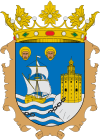Torre del Oro
The Torre del Oro (German: Gold Tower ) is in Seville , once the most important port city in Andalusia . It is a military tower - separated from the rest of the actual city wall. Its name is derived from a non-preserved - possibly yellow and only surrounding the window wreath - tile cladding, which showed golden glittering reflections in the sun.
history
The tower was built in the first third of the 13th century by order of the governor Abū l-ʿUlāʾ, who was appointed by the Almohads residing in Marrakech ( Morocco ) .
In the original Cantabria coat of arms, the Torre del Oro was represented as a shipping symbol.
function
From the base of the tower, a heavy iron chain was led under water to the other side of the Guadalquivir river to the now unsuccessful 'Torre de la Fortaleza'. In this way the port of Seville could be protected against (war) ships traveling upstream. However, Ramón de Bonifaz should manage to break the chain with the Castilian fleet, thus Ferdinand III. in 1248 helped to conquer Seville ( Reconquista ).
In the Middle Ages , the tower served as a prison, and from the 16th century as a depository for precious metals, which were brought in at regular intervals by the Spanish silver fleet from the colonies overseas. This function could be another reason for its naming.
Since July 24, 1944, the Torre del Oro has housed the Maritime Museum Museo Naval de Sevilla with engravings, nautical charts, models, old nautical instruments and other historical documents.
architecture
The twelve-sided Torre del Oro - a dodecagon - is essentially made of stone. Parts of the wall surfaces - as well as the only partially preserved city wall of Seville - are, however, built using the rammed earth technique from southern Morocco; However, the corners were completely made of stone for reasons of stability. The slim, twelve-sided lantern is built using the same technique, but in contrast to the substructure - possibly added at a later date - has pilaster strips at the corners. The upper round tower tower by Sebastián Van der Borcht dates from 1760.
Due to its military function, the tower - apart from the tiles mentioned - had no decoration, only a wreath of double windows set off by a small cornice loosens the severity of the structure in the upper part a little. The platform of the tower is surrounded by a wall with a crenellated crown.
meaning
The Torre del Oro can be regarded as one of the few (surviving) successor buildings of the Pharos of Alexandria - probably also broken polygonally in its middle part and terminating with a lantern . A similar, but octagonal building from the Almohadic period is in Badajoz ( Estremadura ) - the "Torre de Espantaperrus".
literature
- Hermann Thiersch : Pharos. Antiquity, Islam and Occident. A contribution to the history of architecture . Leipzig and Berlin: Teubner-Verlag, 1909
Web links
Coordinates: 37 ° 22 ′ 56.7 " N , 5 ° 59 ′ 46.5" W.


